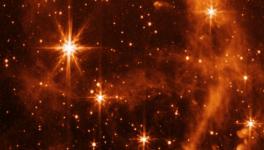James Webb Telescope to Study Cold Mysterious Belt of Solar System

James Webb Space Telescope with its large mirror. Source: Wikimedia Commons.
The latest, advanced and most powerful space observatory, the James Webb Space Telescope, is on a mission to gather information about the origin of the universe as far as possible. The telescope, equipped with sophisticated instruments for the endeavour, is on a mission to study celestial bodies in the Kuiper Belt.
The Kuiper Belt is a disc in the outer solar system that extends from the orbit of Neptune at 30 AU (one astronomical unit = around 150 million km) and till 50 AU from the Sun. The telescope will study thousands of celestial objects in the belt. Pluto, which is no longer a planet, belongs to the Kuiper Belt and the observatory will also include this dwarf planet in its analysis.
The trans-Neptunian celestial objects are of interest as they show remarkable diversity in terms of colour, shape, size and clustering characteristics coupled with geographical and geological activities.
Some of the previous missions, like that of the National Aeronautics and Space Administration’s (NASA) New Horizons, which have flown past these objects could only observe them for a short time—but scientists expect that the telescope, with its sensitive infrared cameras and powerful reflecting mirror, will study them in detail for a long time.
Heidi Hammel, a Webb interdisciplinary scientist for solar system observations, said: “Using Webb, we will be able to get information about surface chemistry, which might be able to give us some clues into why there are these different populations in the Kuiper Belt."
Going beyond, scientists expect the mission to analyse data which may lead to the formative years of the solar system. An astronomer at Cornell University and a Webb interdisciplinary scientist said: “These are objects that are in the graveyard of solar system formation.” He noted that the objects likely have been around for billions of years and could last billions more.
In addition, the telescope will also study centaurs, celestial objects that once belonged to the Kuiper Belt but whose orbits have now been altered and they are now closer to the Sun and settled somewhere between Jupiter and Neptune. One example of such a centaur is Triton, which is Neptune’s moon. “Even though it’s Neptune’s moon, we have evidence to suggest that it is a Kuiper Belt object that got too close to Neptune sometime in its past and it was captured into orbit around Neptune,” Hammel said.
The telescope was launched on an Ariane 5 rocket from Europe’s spaceport in French Guiana, South America, at 7:20 AM EST on December 25. The mission is a joint effort by NASA, the European Space Agency and the Canadian Space Agency with the aim of finding the light emanating from the early universe’s first galaxies by exploring the solar system and the exoplanets—planets that orbit stars other than the Sun.
The Webb differs from its predecessors like the Hubble Space Telescope in several ways. The first is the capability of the observatory in its 6.5-metre wide golden mirror, which is three times wider than that of Hubble’s. Its enlarged reflector and sensitive instruments will enable astronomers to have a deeper look into the space and go back in time than was achievable ever before. The large reflector has 18 segments, each having tiny motors on the back. The reflector will have to be focussed to receive infrared wavelengths from the early stars of the universe.
Get the latest reports & analysis with people's perspective on Protests, movements & deep analytical videos, discussions of the current affairs in your Telegram app. Subscribe to NewsClick's Telegram channel & get Real-Time updates on stories, as they get published on our website.





















